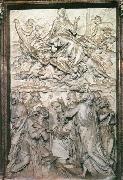
Oil On
Canvas, Real Flavor of Old Masters
|
Gian Lorenzo Bernini
|
|||
|
|
|||
| Italian sculptor , b. 1598, Napoli, d. 1680, Roma ,Italian architect and artist credited with creating the Baroque style of sculpture. He began his career working for his father, a sculptor. Among his early sculptures are Apollo and Daphne (1622 -C 24) and an active David (1623 -C 24). Under the patronage of Urban VIII, the first of eight popes he was to serve, he created the baldachin over the tomb of St. Peter in Rome. Bernini's architectural duties increased after 1629, when he was appointed architect of St. Peter's Basilica and the Palazzo Barberini. His works often represent a fusion of architecture and sculpture, as in the Cornaro Chapel, in Santa Maria della Vittoria, Rome, with its celebrated theatrical sculpture, The Ecstasy of St. Teresa (1645 C 52). His greatest architectural achievement is the colonnade enclosing the piazza before St. Peter's. | |||
|
|
|||
|
|
The Assumption new21/Gian Lorenzo Bernini-962555.jpg Painting ID:: 62359 Visit European Gallery |
1607-10 Marble Santa Maria Maggiore, Rome This relief was commissioned for the sacristy of the Santa Maria Maggiore. Inspired by contemporary paintings of the subject (particularly by Ludovico Carracci), Pietro Bernini's relief illustrates his virtuoso marble-carving ability and his exploitation of pictorial affects, more skills that he passed on to his son, the young Gianlorenzo. At the same time the relief is rooted in an approach to relief sculpture which differs little from the famous scenes of the life of the Virgin by the fourteenth-century Florentine sculpture Andrea Orcagna. We find in this composition the sharp linear drapery style and the extreme tenseness of the figures that characterize Pietro's art, never entirely freed from the Mannerist limitations of his training. The work, however, is one of the earliest examples of the pictorial relief altarpieces that were to be popular during the 17th century | |
Height Width |
INS/CM |
||







